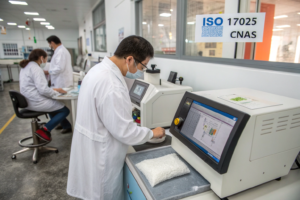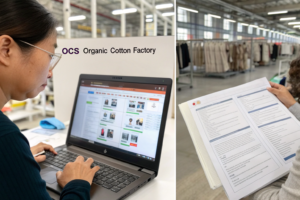Colorfastness to perspiration is a crucial quality indicator in fabric sourcing—especially for activewear, uniforms, and garments meant for warm climates. If your fabric bleeds or fades under sweat exposure, it can damage your brand and increase return rates. Many buyers see lab test reports filled with numbers like "4-5" or terms like "acidic solution," but don’t know how to interpret them.
Colorfastness to perspiration refers to a fabric’s ability to retain its original color when exposed to human sweat. Lab test reports rate this resistance using gray scale scores across color change and staining, under both acidic and alkaline conditions.
This guide will walk you through how to interpret these reports, what test methods are used, and how to ensure your suppliers meet international quality benchmarks.
What Does “Colorfastness to Perspiration” Actually Test?
Colorfastness to perspiration simulates how fabric reacts to sweat during wear. Since perspiration varies in pH, fabrics are tested under both acidic and alkaline conditions.
The test checks for two things: color change of the original fabric, and staining on adjacent fabrics—rated separately using standardized gray scales.

What Test Methods Are Commonly Used?
The most widely accepted standards include:
- ISO 105-E04 (International)
- AATCC 15 (U.S.)
- GB/T 3922 (China)
These involve soaking fabric in artificial perspiration, layering it with undyed multifiber cloth, and compressing it for 4–6 hours at body temperature.
Sources like AATCC and ISO.org publish full procedural guides. Suppliers who export globally typically align their labs with ISO or AATCC test methods.
Why Test in Both Acidic and Alkaline Sweat?
Human sweat ranges from pH 4.5 (acidic) to 8.5 (alkaline), depending on diet, activity, and skin condition. Fabrics exposed to both must be tested in both conditions.
Brands like Nike and Adidas require dual-condition tests for sportswear. Acidic tests often affect red and blue shades, while alkaline sweat is harsher on black and reactive dyes.
How Are Test Results Rated on the Report?
When you receive a lab report, it typically includes a table with numeric scores—usually from 1 (poor) to 5 (excellent). These are based on gray scales, which are industry tools for measuring subtle color shifts.
A rating of 4–5 for both color change and staining under acid and alkali conditions is generally considered excellent and suitable for most applications.

What Do the Ratings Mean in Practice?
| Rating | Description |
|---|---|
| 5 | No change or staining |
| 4 | Slight change |
| 3 | Noticeable change |
| 2 | Significant fading |
| 1 | Severe bleeding |
For example, a score of 4-5 on color change (acid) means the original fabric hardly changed. A 3 on staining (alkali) means nearby fabric picked up slight dye.
Sources like Testex and Intertek explain how these grades are evaluated using lightboxes and color comparison.
Why Do Reports Show Different Scores for Acid and Alkali?
Different dyes react differently to pH levels. For instance, direct dyes often fade more in acid, while reactive dyes may bleed in alkali. Reviewing both conditions ensures your fabric performs in varied climates or against different skin types.
We recommend setting a minimum 4/3/3 (color change, staining-acid, staining-alkali) for fashion textiles, and 4/4/4 for activewear or uniforms.
What Fabrics and Dyes Perform Best in These Tests?
The dye class and fiber type play a huge role in colorfastness. Some combinations are inherently better suited for sweat resistance than others.
Polyester fabrics with disperse dyes and well-fixed reactive dyes on cotton or modal typically achieve higher perspiration fastness ratings.

Which Fiber-Dye Combinations Give Best Results?
- Polyester + Disperse Dye: Consistently scores 4–5 in both categories
- Cotton + Reactive Dye: Up to 4–5 if fixed and washed properly
- Nylon + Acid Dye: Requires post-fixation and pH control for stability
Labs like SGS and TÜV Rheinland test across combinations. We advise buyers to avoid direct dyes on cellulosic fibers for garments exposed to sweat.
Are There Any Treatments to Improve Results?
Yes. Post-dye treatments such as cationic fixatives, enzyme washes, and resin coatings can enhance sweat resistance—especially for cotton and viscose. At Fumao Fabric, we offer a finishing line that applies anti-bleed coatings for improved color retention.
See Huntsman Textile Effects for examples of post-dye chemical treatments designed to meet perspiration fastness targets.
How to Request Reliable Colorfastness Reports from Suppliers?
When sourcing globally, especially from China, India, or Vietnam, it’s vital to verify the authenticity and relevance of test reports. Don't settle for outdated or incomplete documents.
Ask for ISO or AATCC-certified test reports for the exact fabric, color, and batch—along with details on test lab, conditions, and gray scale reference.

What Should Be Included in a Standard Report?
- Fabric name and composition
- Test method (e.g., ISO 105-E04)
- Ratings for:
- Color change (acid and alkali)
- Staining (on wool, cotton, nylon, etc.)
- Test date and lab stamp (SGS, ITS, CNAS etc.)
At Fumao Fabric, we link each roll’s lab report to a QR code—so importers and brands can instantly access the test results and ensure compliance with EU or U.S. buyer standards.
Can You Use These Reports for Brand or Regulatory Audits?
Absolutely. Many fashion labels—especially OEKO-TEX and GOTS-certified brands—require internal QA proof of colorfastness under perspiration. Submitting verified lab reports helps you pass quality audits and avoid claims.
See guidance from OEKO-TEX® and ZDHC on how colorfastness is part of sustainable and safe textile production.
Conclusion
Reading a fabric test report for colorfastness to perspiration isn’t as intimidating as it seems. Once you know how to interpret the gray scale ratings, test methods, and dye-fiber behavior, you can make confident sourcing decisions. Whether you’re buying activewear, uniforms, or babywear, always demand perspiration test results from your supplier. At Fumao Fabric, we help buyers get lab-backed confidence in every meter they import—because color should last as long as the garment does.










